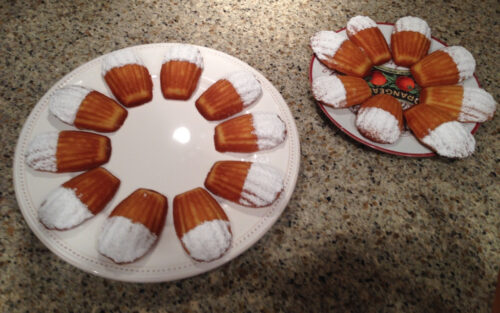
PRERPARATION:
Whisk together the flour, baking powder and salt in a small bowl; set aside.
Working in a large bowl, rub the sugar and lemon zest together with your fingertips until the sugar is moist and fragrant. Add the eggs and whisk energetically. You want the egg-sugar mixture to thicken ever so slightly and pale just a little; this could take a couple of minutes (if you’d like, you can use a mixer). When the whisk leaves tracks, beat in the honey and vanilla. Using a gentler touch—and a flexible spatula, if you’d like—fold in the dry ingredients, folding only until they disappear into the batter. Finally, fold in the warm melted butter and, when it’s incorporated, the milk. You’ll have a smooth, shiny batter. Press a piece of plastic film against the surface of the batter and chill for at least 1 hour. (The batter can be kept in the refrigerator for up to 2 days.)
An hour or so before you’re ready to bake, butter the molds of a 12-shell madeleine pan, dust with flour and tap out the excess. Even if you have nonstick or silicone madeleine molds, it’s a good idea to give them the butter- flour treatment. (Alternatively, you can use baker’s spray, a mix of vegetable oil and flour.)
Spoon the batter into the molds—don’t worry about spreading it evenly; the oven’s heat will take care of that—and refrigerate for 1 hour more. (You can cover the batter lightly with a sheet of wax or parchment paper, but inevitably some of the batter will stick, so I leave the pan bare.)
Center a rack in the oven, put a large heavy baking sheet on the rack and preheat the oven to 400 degrees.
Place the madeleine pan on the hot baking sheet and bake for 11 to 13 minutes, or until the cakes are golden and the cakes spring back when pressed with a finger.
Remove the pan from the oven and immediately release the madeleines from the molds by rapping the edge of the pan against the counter.
Gently pry any recalcitrant madeleines from the pan using your fingers or a table knife. Transfer to a cooling rack and allow them to cool to room temperature.
SERVING
Generally served with tea, madeleines are good any time of day or night, with anything from coffee to Cognac. They are a delight warm or at room temperature and even still nice when they’re slightly stale—and perfect for dunking.
STORING
You can make the batter up to 2 days ahead and keep it covered in the refrigerator, but once baked, madeleines are best the day they’re baked.

Ingredients
Enjoy a light flavourful confection!
